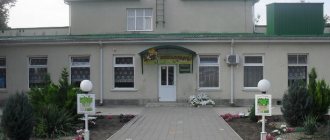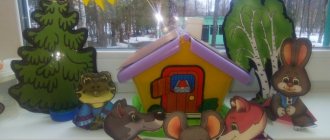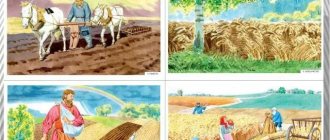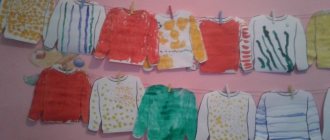Project “Vegetable Garden on the Window”
Yulia Alekseevna Motornaya
Project “Vegetable Garden on the Window”
Material for the competition “Vernissage of Ideas”
teachers of the Khvalynsky district.
Nomination: Vernissage of ideas on the topic: “Miracle garden ”
in Group"
Full name - Yulia Alekseevna Motornaya
Position: educator.
Work experience - 6 years.
Content
1. Relevance of the chosen topic ___ page 3
2. Description of the work to create a subject-development environment___page. 5
3. Organization of children's activities___p. 6
4. Summary of children's activities___p. 7
Conclusion___page 8
1. Relevance of the chosen topic.
Introducing a child into the world of nature, forming realistic ideas - knowledge about its objects and phenomena, cultivating the ability to see the beauty of native nature, love, a careful and caring attitude towards it - are the most important tasks of a preschool institution.
Communication with nature has a positive effect on preschool children, makes them kinder, softer, and awakens the best feelings.
Indoor plants not only provide an opportunity to organize interesting and meaningful educational work with children, they improve the microclimate of the room in which children are: they humidify the air, purify and enrich it with oxygen.
The relevance of this topic is to clarify and consolidate children’s ideas about vegetables that differ from each other in appearance and method of growth, to systematize knowledge about the planting process, to teach them to accept a goal, to determine the subject of work, to select tools and materials for work, to determine the sequence of work actions.
Target:
creating conditions in the group for the development of cognitive interest in research activities, revealing the creative and intellectual potential of preschool children, involving children in practical activities of growing cultivated garden plants .
Tasks:
1. Teach children to care for garden plants .
2. Give children a visual representation of the needs of plants for light, heat, moisture, and soil for plant growth.
3. Develop children's cognitive and creative abilities.
4. Create conditions for parental participation in the educational process.
5. Consciously form the correct attitude towards the nature of the native land, towards human work.
2. Description of the work to create a subject-development environment.
“Subject-Developing Environment”
is a system of material objects and means of a child’s activity that functionally models the content of the development of his spiritual and physical appearance in accordance with the requirements of the basic general educational program of preschool education.
A developmental environment is needed, firstly, in order to raise a successful, independent, proactive, creative child.
In the nature corner we stimulate and support children’s cognitive interest in natural objects; we develop labor skills in caring for living objects; We cultivate a caring attitude towards nature.
Of course, we are helped with this by:
— didactic games aimed at the formation and development of ecological knowledge of the surrounding world;
— models of plant structure, signs of living things, phenological changes in nature;
— albums, photographs, illustrations, paintings;
— weather and nature calendars;
— a selection of poems, proverbs, sayings, signs, riddles about vegetable crops;
- children's drawings and crafts made from natural materials;
— equipment for planting seeds and seedlings;
— «vegetable garden on the window»
The entire group space is available to children: toys, teaching material, games. They know very well where to get equipment for caring for plants, paper, paints, pencils, natural materials, costumes and attributes for stage games.
3. Organization of children's activities.
In March, my children and I worked like bees - doing spring planting: preparing the soil, planting bulbs, oats, tomatoes, cucumbers, dill, watering, loosening, eagerly waiting and watching for the first sprout to appear.
We took care of the plantings with pleasure, and it couldn’t have been any other way! After all, on the windowsill, next to the onion bed, small, smiling “Men”
with mischievous button eyes and a hedgehog whose green needles grow by leaps and bounds.
The changes taking place here are fast, bright, and visual. They put a seed in the ground, said the magic words - and lo and behold, after a few days, sprouts made their way to the light. Day after day they gain strength and grow, delighting children with their greenery. The children are very proud of the results of their work. This is the most beloved, “magical”
place for guys.
In the process of such activities, children consolidate and expand their knowledge about vegetable crops and their use, they master the skills of caring for plants, and begin to understand what an important role conditions play in the life of plants and how people can influence them.
While caring for plants, children observe the growth of plants from seed to seed. They sketch all their observations, creating mini-books, and then tell other children how they grew the plants, what conditions influenced its growth. The children, together with adults, come up with recipes for vegetable dishes.
There is still snow outside the window, but spring is already reigning in the group and pleases with the first greenery. Soon the guys will harvest their first harvest. What could be tastier and healthier than greens grown by yourself!
4. Summary of children's activities.
We gradually collected a collection of seeds. Algorithms for plant care were developed. We made a selection of educational games, poems and riddles about vegetables. We created an album with illustrations of vegetable crops. We made masks of vegetables and fruits to act out fairy tales.
The following experiments were carried out:
— observations of the growth of the onion root system in water;
- germination of pea and oat seeds in cotton wool between transparent planes.
Children watched the growth of plants and kept a diary where they made sketches. We also constructed a basket for vegetables and fruits out of paper, and played educational games “Botanical Lotto”
,
“Find a vegetable by description”
,
“What grows in
the garden ” ,
“Wonderful bag” (vegetables and fruits)
.
“Guess by taste”
, we conducted a role-playing game
“Vegetable shop”
.
They guessed “Riddles in the garden.”
We had conversations on the topic:
“What kind of crop has grown
,
“What is growing in your
garden .” We composed a descriptive story on the topic:
“How we grew vegetables
.
And, of course, we read fiction: N. Nadezhdin’s “Where the cabbage soup is, look for us there!”
, Y. Taits
“Obedient Rain”
, Y. Tuvim
“Vegetables”
, V. Suteeva
“Apple”
.
Russian folk tale “Tops and Roots”
, Belarusian fairy tale
“Puff”
, Ukrainian fairy tale
“Spikelet”
. They painted a still life with vegetables, sculpted vegetables and fruits.
They worked caring for plants in a corner of nature.
Conclusion
The children enjoyed tasting the greens they had grown with their own hands. An exhibition of children's works was organized. But our concern for vegetable crops did not end there; we will plant our seedlings in the garden and look forward to the harvest.
The vegetable garden on the window has become a good help and assistant in instilling an ecological culture in children, creating the right attitude towards living nature. He is able to expand children’s ideas about plants as living organisms, about the conditions necessary for growth and development, develop an ethical sense, the ability to enjoy the beauty of the plants grown and the result of their work.
Do I need to talk about how nice it is to serve in winter (spring)
to the table dishes decorated with green sprigs of parsley and dill. And beautiful and tasty, and good for the health of our children. And most importantly, it is accessible to everyone, and children raised it.
Project for the preparatory group “Vegetable garden on the windowsill”
Project for the preparatory group
"Garden on the windowsill"
(the project is designed for 7 weeks)
Project participants
: children of the preparatory group, teacher, parents.
Project type
: practical
Content section:
cognitive and research activities.
By number of participants
: group.
By time:
long-term.
Information sources:
methodological literature, Internet resources.
RELEVANCE.
Winter is ending. The sun is getting higher and higher every day, and the days are getting longer and warmer. It's time to plant. Vegetable gardening on a windowsill in a kindergarten is a very pleasant activity, especially in winter and spring, when you want not only to taste the fresh gifts of nature, but also to look at the colors of greenery or tomatoes. But there is nothing more pleasant than the first greenery of spring, which pleases the children right in the group room on the windowsill. It can be onions, parsley, dill, and even lettuce. A vegetable garden on a windowsill is a great way to dispel the seasonal longing for natural colors and warmth. Expanding children's ideas about how to care for plants indoors, generalizing ideas about the need for light, heat, soil moisture for plant growth, and developing children's cognitive and creative abilities.
Target:
To generalize and expand children’s knowledge of how to care for plants indoors; involve parents in co-creation.
Tasks:
1. Teach children to care for plants indoors.
2. To form in children the concept of the relationship between nature and people: people plant, grow and care for plants, plants grow, delight people with their beauty, and feed them with their fruits.
3. Summarize children’s ideas about the need for light, heat, and soil moisture for plant growth.
4. To develop children’s cognitive interest while growing plants indoors.
5. Foster a caring attitude towards your work, and the work of adults and children.
6. Learn to carry out individual assignments and collective tasks.
7. To develop the ability to negotiate with the teacher about the distribution of work, a responsible attitude towards the assigned task.
8. To consolidate children’s knowledge about the structure of the bulb, about the conditions necessary for plant growth; develop children's speech, activate vocabulary (root, onion, plant, deepening, terms, arrow).
9.Cultivate a desire to achieve results, a sense of responsibility for participation in a common cause.
10. Explain the importance of work.
11. Cultivate respect for working people and careful attitude towards their results.
12.Form the child’s positive relationships with both adults and peers.
13.Develop children's sense of community in the group and cooperation skills.
14. Foster a respectful relationship between the child and adults.
Project idea:
create a vegetable garden on the windowsill in the group room of the kindergarten.
Working with parents.
1. Make a selection of poems, riddles about vegetables, and recipes for vegetable dishes.
2. Invite parents to purchase containers, soil, seeds for planting, sticks for loosening, and watering cans for the project.
3.Homework - with the children, come up with a fairy tale about any vegetable, write it down and draw a picture for it.
Joint activities of children and teacher
: experiments, observations, experiments, examining and planting seeds, didactic games,
conversations about the rules of caring for plants indoors, reading fiction about vegetables, sketches, an exhibition of children's drawings and plasticine crafts, making index tables with the names of plants and planting dates, caring for plants.
Expected results.
Children will develop knowledge about the growth of plants in indoor conditions: for the life and growth of plants, light, water, heat, and nutritious soil are simultaneously necessary (in low light conditions, plants stretch towards the light, leaves and stems turn pale; without heat, seeds do not germinate, leaves do not bloom ; without water, plants dry out)
STAGE 1
– preparatory (within 1 week).
The kindergarten group planted a vegetable garden on the windowsill. We made index tables with the names of plants (date of planting and first shoots). We selected fiction: sayings, poems, fairy tales, riddles about vegetables.
STAGE 2 – research (5 weeks).
Children watched the growth of plants, conducted experiments, experiments. Connections were established: plants - earth, plants - water, plants - light. The results of the experiments were recorded in drawings. In the process of research, children became acquainted with fiction about vegetables: sayings, poems, fairy tales, riddles. We looked at illustrations and paintings. Classes, didactic games, and conversations were held. The seeds were examined and planted.
.
STAGE 3
—
final (within 1 week)
We analyzed and summarized the results obtained in the process of children’s research activities. We designed a wall newspaper “From Seed to Sprout”, which presented photographic material on caring for indoor plants. We prepared a vegetable salad and invited the parents to join the group for a treat. Next, the children presented their homework - a fairy tale about vegetables with illustrations for it.
Organizational activities of the teacher for the implementation of the project.
1. Select fiction and illustrated material on this topic.
2. Organize work with parents to implement the project.
3. Select materials and equipment for experimental activities.
4.Draw up a long-term action plan.
Project Implementation Plan
.
Preparatory stage.
1.Collecting fiction: poems, riddles, proverbs, sayings, short stories, fairy tales about vegetables (joint activity with parents). Ecological fairy tales (group teacher) – last week of February.
2. Consultation for parents: “We are participating in the project “Vegetable garden on the windowsill” (group teacher, parents) - last week of February.
3.Purchase of necessary equipment: containers, soil, fertilizers, seeds (parental committee) - last week of February.
4. Setting up a vegetable garden on the windowsill. Children, teacher (last week of February)
5. Making sign boards with the names of plants. Children, teacher (last week of February)
Research stage.
1. Examination of seeds and planting.
2. Experimental activities: “Structure of plants”, “Conditions necessary for plant life”, “Reproduction, growth, development of plants”. (group teacher, children) – (4th week of February – 2nd week of March)
3. Classes with children: “Garden plants”, “Tops and roots”, “Sowing seeds”, “Vegetables” (group teacher) During the entire project.
4. Conducting didactic games: “Find out by touch”, “Find out by taste”, “What vegetable is this part from?”, “Harvesting”, “Find out what’s in the basket”, “Vegetable salad”, “Cooking soup” and others (group teacher) Throughout the project.
5.Learning poems, riddles, sayings about plants with children; examination of illustrations, paintings depicting vegetables (compare them by color, shape, size, taste) - group teacher. Throughout the entire project.
6. Conversations about how to grow vegetables in the garden, about the rules of caring for plants indoors (group teacher) Throughout the project.
The final stage.
1. Design of the wall newspaper “From seed to sprout” (children, parents, group teacher) – 1st week of April.
2. Conducting the competition “Guess the name of the vegetable” (group teacher - 1st week of April)
3. Children’s performance with homework. Presentation of a fairy tale about vegetables, examination of drawings for the fairy tale (group teacher - 2nd week of April)
Implementation plan for working with children and parents
project “Vegetable garden on the windowsill”.
| Events | Goals | Responsible |
| 1. Conversation with parents “Introduction to the project.” Designing a parent's corner, posting recommendations for parents on working with children on the project. | Involve parents in the implementation of the “Vegetable garden on the windowsill” project. | teacher |
| 2. Conversation with children about what a garden is and what grows in it. | Expand children's horizons. | teacher |
| 3. Collecting seeds, preparing the land, creative garden design. | Foster hard work; develop children's creativity. | teacher |
| 4. Joint creation of a vegetable garden in a group. Planting vegetable seeds and bulbs. | Cultivate a desire to help adults. | teacher |
| 5. Photo report “How we care for plants.” | Invite all children in the group to work together. | teacher |
| 6. Learning nursery rhymes, proverbs, sayings, songs related to the garden. | Introduce folklore works related to the vegetable garden. | teacher, music director |
| 7. Examination of illustrations and pictures. Children's drawing of vegetables. | Foster a desire to be creative on your own. | teacher |
| 8. Carrying out creative work (drawings, crafts) together with parents according to the theme of the project. | Develop creative abilities and the ability to work together with adults. | parents |
| 9. Caring for seedlings together with children: watering, loosening, thinning. | Learn to care for plants. | teacher |
| 10. Photo report for parents. | Teach children to enjoy the work done, to enjoy the results of their work. | teacher |
| 11. Guessing riddles about vegetables. | Develop ingenuity, memory, attention. | teacher |
| 12. Examination of models of vegetables and fruits, clarification of shape and color. | Form children's understanding of vegetables. | teacher |
| 13. Modeling vegetables from plasticine. Design of the mini-exhibition “Our Harvest”. | Learn to use previously acquired skills while sculpting. | teacher |
| 14. Game dramatization of the Russian folk tale “Turnip”. | Develop children's acting abilities. | teacher |
| 15.Creating a photo album “Vegetable garden on the windowsill.” | Summarize the work done. | teacher |
Result (presentation) of the project:
Review of the wall newspaper “From seed to sprout” (children, parents, group teacher)







